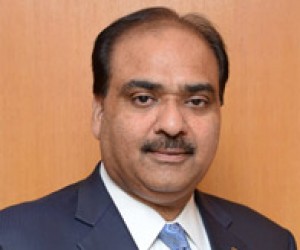Sanjeev Sardana, Vice President: Indian Electrical & Electronics Manufacturing Association (IEEMA) and former Chairman of ELECRAMA, shares his thoughts on the electrifying dynamics of the electrical and electronics industry in India and how it impacts global players, on the occasion of their participation in the upcoming African Utility Week in Cape Town.
Let’s start with some background of IEEMA, the history of the organisation etc.
The foundation of Indian Electrical & Electronics Manufacturing Association (IEEMA) dates back to 1948 when eight Indian companies decided to create a platform for promotion of Indian Electrical Manufacturers’ Association (IEMA). The establishment of the association synchronized with the independence of India, reflecting the faith of Indian industrialists in the growth of various individual sectors of economy in the atmosphere of freedom. With that intention, IEEMA, today, is the first ISO certified industry association in India with 800+ member organisations encompassing the complete value chain in power generation, transmission and distribution equipment. IEEMA members have contributed to more than 90% of the power equipment installed in India. It is recognized as the representative organization of the Indian electrical and electronics industry.
What kind of projects do you run for your members?
IEEMA, as the voice of the industry, undertakes various activities and a number of cross sectoral initiatives for its members, maintains a dialogue with the Government, utilities, other users, standardization bodies, educational, research, development and testing institutions. IEEMA also organizes divisional meetings and training programs for its member at regular intervals to keep them updated on the latest technology and best practices in the industry.
You also organise ELECRAMA – a biannual exhibition for the industry. How has the event changed over the years?
ELECRAMA is an ideal platform for World Electricity Forum, where all stakeholders of the global electrical sector come together to shape the contours of the future of global electricity landscape. Today the industry stands at a point where it is leading the race and has achieved global reputation. ELECRAMA 2016, in particular, was a paradigm shift where we had top utilities of the world who came and chose relevant topics with regard to what the world is facing in terms of power generation, transmission and distribution.
What made you decide to bring an official Indian delegation to African Utility Week?
Since African Utility Week is one of the best professionally organized exhibitions for the power sector in the entire African sub-continent. We decided that it would be appropriate to have presence of the Indian Manufacturers as exhibitors, as they can get an opportunity to interact with various decision makers of Power Utilities, Consultants and Contractors who visit this exhibition from the majority of African countries. This would give them an opportunity and understanding of the African Power Sector and how can they leverage the opportunity for mutual growth.
How interested is the Indian utility vendor and services market in the African sector?
To state the relevance of the service industry, the largest power transmission company of India, Power Grid Corporation of India is consultant to Government of Kenya and Ethiopia and has successfully implemented and modernized their transmission network. Another largest Indian Government manufacturer Bharat Heavy Electricals Limited (BHEL) has already installed 20,000 MW power equipment in various African countries which is working satisfactorily and giving consistent power supply. Since, African Continent comprising of 1.75 Billion population with only 9% of the total population having access to electricity, Indian manufacturers and service providers in electrical sector would like to be partners in progress in this sector by bringing quality products and services. Indian exhibitors are also interested in transfer of technology required for making various electrical equipment for Small & Medium Enterprises in Africa. This will help them in reducing import dependence and eradicating poverty by creating job opportunities for engineers and workers. As we understand from various multilateral funding agencies, billions of dollars have to be spent in the next two decades for creating power infrastructure in Africa which is a basic necessity for the growth of the continent. We as Indian Electrical and Electronics Manufacturers’ Association (IEEMA) are committed to energise Africa.
What can visitors to this year’s AUW Expo expect when they visit the Indian Pavilion?
On display at the AUW Expo will be conductors, cables, cable accessories, polymer insulators, transformers and smart meters. Apart from that officials of IEEMA would be present to discuss about joint venture opportunities with respective partners.
What excites you about this industry?
Since we are an organisation comprising 800+ companies manufacturing 90% of power equipment required for power generation, transmission and Distribution having turnover of US$25 billion and exporting US$5 billion worth of equipment, out of which more than 50% is sold in African Subcontinent. The Indian Government has created special Ministry of Skill Development, where we are working closely with the Ministry of Power for developing Skills for the Power Sector. With the Government’s ambitious plan of investing US $ 250 billion in next 5 years for developing & enhancing the installed capacity in generation, India would need at least 3,00,000 engineers. We have an installed capacity of 2,90,000 MW and are going to add additional 100 GW in next few years. So opportunities are in abundance & at the same time challenges as well to achieve it in time. African continent is of great importance to us as there are plenty of opportunities to be part of development.
What can South Africans learn from the Indian utility sector?
I am sure there are a lot of key takeaways from the success of Indian utilities that can be replicated in the African region. Power Grid Corporation of India Limited (POWERGRID, the 'Central Transmission Utility (CTU)' of the country and a 'Navratna' Company operating under Ministry of Power, is engaged in power transmission business with the responsibility for planning, implementation, operation and maintenance of Inter-State Transmission System(ISTS) and operation of National & Regional Power Grids. POWERGRID, owns & operates around 1,28,201 ckm of Extra High Voltage (EHV) transmission lines spread over the length and breadth of the country and 206 EHV AC & HVDC Sub-stations with transformation capacity of more than 2,49,579 MVA. Its vast transmission network wheels about 46% of the total power generated in the country. The availability of this huge transmission network is consistently maintained over 99% through deployment of state-of-the-art operation & maintenance techniques at par with global standards. Another “Navratna” company, NTPC (National Thermal Power Corporation), which is also India’s largest energy utility, with presence in the entire value chain of the power generation business. NTPC provides growth momentum to the sector creates benchmarks of operational excellence and promotes sustainable energy development. With the total installed capacity of 46,653 MW, the company has set a target to have an installed power generating capacity of 1,28,000 MW by the year 2032.
How important is renewable energy in the energy mix in your country?
India has now taken a lead position in promoting renewable energy in the world and is helping set up an International Solar Alliance (ISA), an alliance of 121 solar resource rich countries located fully or partially between Tropic of Cancer and Tropic of Capricorn. This Alliance was jointly launched by the Prime Minister of India and the President of France on 30th November 2015 at Paris, France on the side-lines of the 21st Conference of Parties to the United Nations Framework Convention on Climate Change. The sector has an investment potential of $250 billion by 2022 with about $120 billion of investments coming in renewable sector along where we are running the world’s largest renewable energy expansion programme. About $100 billion will be invested in generation and transmission sectors with the remaining in the distribution and energy efficiency sectors.
What are you and the other members of the IEEMA delegation looking forward to at AUW in Cape Town in May?
We are all looking forward to meeting some senior officials from the power sector and pursue global partnerships. This is primarily a step towards development and mingling the common idea of mutual progress and prosperity which will facilitate the way towards mutual India-Africa socio-economic transformation.






